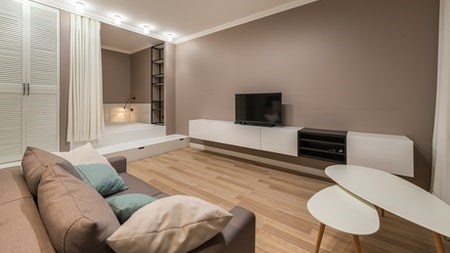One of the quickest – and least expensive - ways to change the look of any room is to give it a new coat of paint.
You can make a large room look smaller and cosier by painting one wall a darker shade. To visually expand a room, try painting the walls a darker colour and trim a lighter shade within the same colour range. This is especially effective if the room has detailed trim on the walls. Painting the walls and trim in contrasting colours or adding a darker colour to one particular wall will alter the entire look and feel of a room.
And remember - the old rule of sticking with one shade and one texture in a room is long out of date. Just tweaking textures and colours can transform a room.
The colour wheel
With so many colours and textures to choose from, the task of selecting the right paints for your purpose may seem daunting. A good rule of thumb is to start with the colour wheel.
The primary colours - red, yellow and blue - are on the colour wheel at 12 o’clock, 4 o’clock and 8 o’clock respectively. Combining any of these will create a secondary colour – purple, orange, or green.
Colours close to each other such as blue and purple are similar and each will allow the other to stand out.
Colours opposite each other - such as green and red – tend to complement each other.
Warm colours have cool ones as their complementary colours while cool colours have warm complements.
Shades are either pure or vibrant; muted - which are less intense than their vibrant counterparts; or shaded. These are the darker colours in the same colour range.
The right atmosphere
Defining the function of the room will help you determine the kind of mood that you want to create.
Ask yourself whether a bedroom will be solely used for resting or will you also be working or studying there? Is your kitchen used strictly for cooking, or does it double as an entertainment area?
The amount of natural daylight your room receives will also affect how colour schemes appear in that space. For a wall that receives direct sunlight during the day, for instance, paint it with a deeper shade of your chosen colour to prevent it from looking washed out in bright light.
Painting with cool colours such as blues, greens and purples make small rooms appear larger and airier.
Staying within the same shade of green will give you a subtle and soothing look.
Reds, yellows, and oranges will create a more vibrant room.
Variations
All the colours and textures on offer make it easy to bring in variations.
To vary the warmth of reds or yellows, choose muted shades of those colours such as peach, pink, or creamy yellow.
Light colours such as blues, lavenders, pinks, and soft yellows are ideal for a feeling of restfulness in a room.
For a calm ambience in your bedroom, choose lighter shades of either cool or warm colours on walls, complemented by different textures in beddings and accessories.
Sage is currently a popular colour for kitchens, creating feelings of comfort, and buttery yellows are reminiscent of freshly-baked treats.
Cost-effective
It isn’t necessary to spend a lot of money on professional services to redo the look of your home. With a little paint and some imagination, you can change the look and feel of any room within a day or two.




